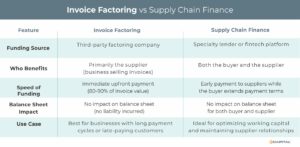
Invoice Factoring and SCF - Off-Balance Sheet Financing Solutions to Support Growth During Uncertainty
Content
During 2025 Q1, moderate growth has reversed course and transformed into extreme uncertainty amid inflation, trade uncertainties, and geopolitical tensions. As a result, companies must adapt quickly to navigate a rapidly changing landscape. Stagnation is a risk no company can afford – growth builds resilience in the face of constant change, making it essential to long-term success.
The challenge is to balance growth investments while maintaining financial health and stability. Access to capital is crucial for growth, and reliable cash flow is essential for stability. Companies must be agile and resilient to manage risks and seize opportunities, yet traditional lending options typically come with restraints. Debt limitations and restrictive loan covenants can hinder a company’s ability to scale. To adjust, many business leaders are turning to flexible financing solutions that provide fast access to capital without compromising financial positions.
Off-balance sheet financing is a category of funding strategies that offer a key advantage in this regard. These methods, such as invoice factoring and supply chain finance, do not appear as liabilities on the balance sheet, helping businesses maintain favorable financial ratios for investors. This allows companies to grow without restrictive loan covenants, overextending credit, or diluting equity.
This article explores two prominent financing options within the off-balance sheet financing category. Invoice factoring and supply chain finance are effective solutions for quickly optimizing working capital, preserving balance sheet flexibility, and avoiding the need for long-term debt.
What is off-balance sheet financing?
Off-balance sheet financing is a category of funding options providing a way for companies to meet their capital needs without directly impacting their balance sheet. By leveraging this type of financing, businesses can expand operations, purchase equipment, or manage working capital without increasing reported debt or liabilities. This flexibility is especially important in 2025, as companies may need to optimize cash flow, preserve borrowing capacity, and maintain investor confidence during economic instability or while waiting for more favorable market conditions.
There are several types of off-balance sheet financing, each suited for different financial needs. Some common types include the following:
- Operating Leases: A company rents an asset (such as equipment or property) rather than purchasing it. The lease payments are considered operating expenses, not liabilities.
- Special Purpose Entities (SPEs): A company creates a separate entity to hold certain assets or liabilities. The SPE can be used to isolate financial risks, such as from complex investments or loans.
- Sales/Leaseback Agreements: A company sells an asset, such as property or equipment, to a financial institution and then leases it back. This allows the company to maintain use of the asset while freeing up capital.
- Invoice Factoring: A company sells its accounts receivable (outstanding invoices) to a third-party factoring company at a discount in exchange for immediate cash flow. The factoring company takes over the responsibility for collecting payments.
- Supply Chain Finance (Reverse Factoring): A buyer enters into an agreement with a financial institution to pay their suppliers early. The supplier receives immediate payment, while the buyer extends payment terms.
Each of these strategies can be classified by their intended purpose. For example:
- Operating leases, SPEs, and sales/leaseback arrangements are typically more suited to companies seeking long-term asset management, tax benefits or to optimize complex financing structures.
- Invoice factoring or supply chain finance are ideal solutions to optimize working capital quickly, maintain balance sheet flexibility, and avoid taking on long-term debt.
Invoice factoring and supply chain finance are game changers for many undercapitalized businesses facing liquidity challenges. These flexible financing solutions provide fast access to capital while preserving financial health to support growth without the constraints of traditional financing.
Invoice factoring and supply chain financing
For many SMBs, invoice factoring and supply chain finance are the financing solutions of choice to stabilize financial structures and maintain a competitive advantage.
Let’s take a closer look at these two options with an example of each to illustrate their effectiveness.
Invoice factoring
XYZ Manufacturing, a rapidly growing company that produces high-quality components for the automotive industry, has recently secured a significant new contract with a large, well-established automaker. This new customer promises substantial orders, but the company faces a challenge: its cash flow is tied up in outstanding invoices from smaller clients, and it needs immediate funds to ramp up production and meet the new customer’s demand.
XYZ Manufacturing turns to off-balance sheet invoice factoring to manage this cash flow gap without taking on traditional debt. By selling its outstanding accounts receivable to a factoring company, XYZ receives an immediate cash advance of 85% of the invoice value, which allows it to purchase additional raw materials and hire temporary staff to expand production capacity.
This strategy allows XYZ to fulfill the large order without worrying about delayed payments from existing clients. Additionally, because the factoring arrangement is off the balance sheet, it does not impact the company’s financial ratios or increase its reported liabilities. This is crucial, as XYZ is in the process of attracting investors to support the relocation of its facilities. The clean balance sheet and improved liquidity position XYZ as a more attractive investment opportunity.
Leveraging supply chain financing
Old Oak, a premium bourbon distillery, distributes directly to markets. This growing operation is expanding into Asian markets and needs significant funding to establish a distribution network and launch a marketing campaign. However, the distillery wants to avoid taking on traditional debt, which could affect its financial ratios and investor appeal. Old Oak turns to off-balance sheet supply chain financing (SCF) to address this.
By partnering with a specialty lender, Old Oak uses SCF to provide early payments to suppliers of logistics services—such as transportation and warehousing—in exchange for a small fee. This enables the distillery to establish a distribution network across key Asian cities, ensuring timely product delivery and efficient storage without impacting its balance sheet.
Additionally, the distillery needs to deploy a multi-media advertising campaign to ensure success in a new region. An investor willing to support a brand awareness campaign is essential to ensure Old Oak’s success in Asia.
By leveraging off-balance sheet financing strategies, Old Oak maintains a clean balance sheet, which enhances its appeal to investors. The distillery’s ability to fund significant operations without traditional debt positions it as a financially stable company and investors are confident in its expansion plans. As a result, Old Oak secures funding to support its growth in the Asian market while preserving its financial health.
Conclusion
Current economic challenges, complicated by trade uncertainties and geopolitical tensions, create a rapidly changing landscape. Businesses must navigate uncertainty by adopting agile strategies supported by flexible financing arrangements.
Off-balance sheet financing offers a powerful solution for companies looking to fuel growth, preserve financial health, and attract investors without the constraints of traditional debt or equity dilution. Whether through invoice factoring or supply chain finance, these methods enable businesses to maintain liquidity, optimize operations, and strengthen their balance sheets, positioning them for success in an ever-evolving market. With the right financing approach, companies can remain agile, resilient, and poised for long-term growth, even in uncertain conditions.
Key Takeaways
- 2025 Q1 has seen moderate growth slow and transform into extreme uncertainty amid inflation, trade uncertainties, and geopolitical tensions.
- Stagnation is a risk no company can afford – growth builds resilience in the face of constant change, making it essential to long-term success.
- The challenge is to balance growth investments while maintaining financial health and stability.
- Invoice factoring and supply chain finance are prominent financing options within the off-balance sheet financing category. These effective cash flow strategies are ideal solutions to optimize working capital quickly, maintain balance sheet flexibility, and avoid taking on long-term debt.
ABOUT eCapital
At eCapital, we accelerate business growth by delivering fast, flexible access to capital through cutting-edge technology and deep industry insight.
Across North America and the U.K., we’ve redefined how small and medium-sized businesses access funding—eliminating friction, speeding approvals, and empowering clients with access to the capital they need to move forward. With the capacity to fund facilities from $5 million to $250 million, we support a wide range of business needs at every stage.
With a powerful blend of innovation, scalability, and personalized service, we’re not just a funding provider, we’re a strategic partner built for what’s next.



